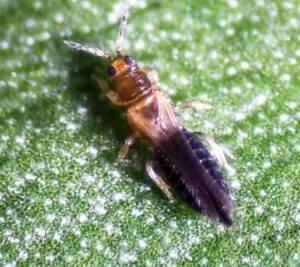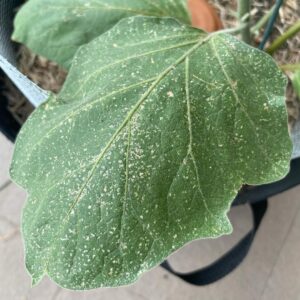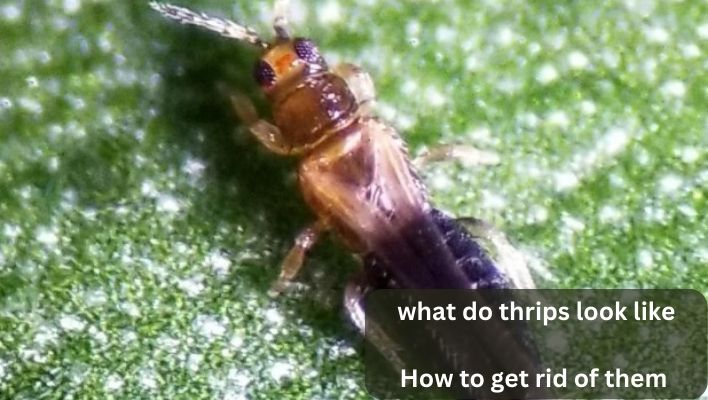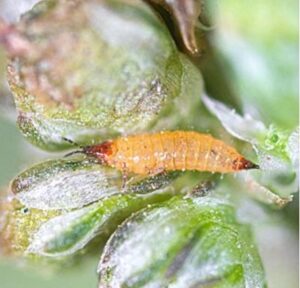Did you notice small black or brown specks on your plants and flowers? Are your leaves turning yellow or brown? You might have a thrips infestation. These tiny pests are a common problem for many gardeners and greenhouse growers, but with the right knowledge and tools, you can get rid of them for good.
These tiny pests can wreak havoc on your plants, causing damage to leaves, flowers, and fruits. Thrips are tiny, winged insects that can cause major problems for gardeners and farmers. These tiny pests can damage plants and reduce crop yields, making them a serious problem for anyone who grows plants. But what exactly are thrips, and what do they look like?
Thrips are tiny insects ranging from about 0.5 mm to 1.5 mm. They have elongated, slender bodies and are typically pale in color, ranging from yellow to brown or black. They have fringed wings, which give them a fuzzy appearance, and they are often mistaken for small pieces of debris or dust.
Thrips feed on various plants, including flowers, vegetables, fruits, and ornamental plants. They damage plants by feeding on their leaves, flowers, and fruits, leading to discoloration, wilting, and even death in severe cases.
This blog post will take a closer look at these tiny pests and give you all the information you need to identify and control thrips in your garden or greenhouse. So, let’s dive in and learn about these pesky insects.
What are they
Thrips are tiny, slender insects that belong to the order Thysanoptera. They are known for their small size, usually measuring only 1-2 mm in length, and their fast-moving, agile behavior. Thrips have two pairs of wings fringed with long hair-like structures. They come in different colors, such as black, yellow, brown, or white.
Thrips feed on various plants, including fruits, vegetables, and ornamental plants. They can cause damage to plants by feeding on the leaves, flowers, and fruits, which can cause leaf curling, discoloration, and scarring. They are known for their fast reproduction and can quickly become a pest and spread plant diseases.
There are over 6,000 species of thrips, some of the most common species that could be found in gardens or greenhouses include:
- Western flower thrips (Frankliniella occidentalis)
- Greenhouse thrips (Heliothrips haemorrhoidalis)
- Onion thrips (Thrips tabaci)
- Tobacco thrips (Frankliniella fusca)
- Melon thrips (Thrips palmi)
Thrips can be difficult to control because of their small size, fast movement, and ability to reproduce quickly. Therefore, it’s important to take preventive measures to control thrips, such as monitoring for the presence of thrips, using sticky traps, and practicing good sanitation in the garden or greenhouse.
What do thrips look like
Thrips are small, slender insects that vary in size and color depending on the species. They typically range in size from 1/25 inch to 1/8 inch long. These pests have a long, narrow body shape with two pairs of wings.
They are usually pale or yellowish, but some species may be dark or black. Some species of thrips have fringed wings, which can help to distinguish them from other small insects.

Adult thrips have two pairs of wings, the first pair being long and narrow and the second pair being small and vestigial. They have a unique mouthpart that allows them to suck the sap from the plant leaves and flowers.
They also have a unique feeding behavior that can cause damage to the plant; they have a rasping-sucking mouthpart that scrapes the surface of the leaf, flower, or stem and sucks the sap out.
Their larvae are similar in shape to the adults but are smaller and usually yellow or green. They are also wingless and are usually found on the underside of leaves or in the soil.
It’s important to note that there are thousands of thrips species; however, they all have similar features and behaviors but with small variations.
Thrips larvae are small and slender, typically measuring about 0.5 mm in length. They have an elongated, cylindrical shape and are usually pale yellow or white. They have six legs but are not as developed as adults, and they cannot move as fast as adults.
Thrips larvae have a transparent body, which makes it difficult to see internal organs, but they have a visible head and thorax. They also have long, thin antennae and mouthparts that are adapted for feeding on plants.
The thrips larvae can be difficult to see with the naked eye and may be mistaken for small white or yellow specks on leaves or flowers. They can be found on the undersides of leaves, on flowers, and on fruit, where they will be feeding on plant sap and causing damage to the plant.
In general, it’s important to monitor the presence of thrips and take steps to prevent and control infestations to keep them from spreading. This can include implementing preventive measures such as using sticky traps, using natural predators, and practicing good sanitation in the garden or greenhouse.
How do you know if you have thrips?
There are several signs that may indicate the presence of thrips on plants:
- Damage to leaves: Thrips feed on the sap of plants, leaving behind small, discolored spots or streaks on leaves. They also cause leaves to become curled or distorted.
- Stippling or Silvering: Thrips can cause small, pinprick-like damage on the surface of leaves, which can appear as tiny white or yellow spots. This is known as stippling or silvering.
- Frass: Thrips excrete fine, black frass (fecal matter) that can accumulate on leaves and stems.
- Discoloration of flowers: Thrips can also feed on flowers, causing them to become discolored or distorted.
- Presence of thrips: The best way to confirm the presence of thrips is by observing them. Thrips are small, slender insects that range in color from yellow to black. They can be difficult to see with the naked eye but can be observed using a magnifying glass.
It’s important to be aware that thrips can be found in both adult and immature stages, so it’s important to check for both. By monitoring the plants regularly, you can quickly identify thrips, which will help you take appropriate action to control them.
Are Thrips Dangerous?
Thrips are not typically considered to be dangerous to humans or animals. However, they can be significant pests for plants and can cause damage to crops and ornamental plants. Thrips feed on the sap of plants, which can cause leaves to become discolored, distorted, or drop off.
They also transmit plant viruses, which can cause serious damage to crops. While thrips are not dangerous to humans or animals, they can irritate if they come into contact with skin or eyes, so it’s best to take precautions such as wearing gloves and goggles when handling plants infested with thrips.

Where do thrips come from
Thrips come from a variety of sources. Some of the most common include:
- The outdoors: Thrips are commonly found in outdoor environments such as gardens, orchards, and fields. They can be carried into indoor spaces on clothing, tools, or other objects.
- Greenhouses: Thrips are often found in greenhouses, where warm, humid conditions are ideal for their survival and reproduction.
- Other plants: Thrips can also be introduced to a growing environment through infested plants. They can be brought in on newly purchased plants or migrate to a new location from neighboring plants.
- Soil: Thrips can also be present in soil and infect plants through the roots.
- Transport: Thrips can travel long distances by being transported on plants, flowers, fruits, or other items shipped or transported by humans.
- Migrating: Some thrips species are known to migrate across regions; this is common in certain parts of the world where they are known to fly and can travel long distances to find food.
It’s important to be aware of the potential sources of thrips and to take steps to prevent them from entering a growing environment, such as inspecting new plants for infestations and regularly monitoring for signs of thrips.
What thrips do to plants
Thrips can cause significant damage to plants when left unattended. They grow rapidly and spread fast in a greenhouse with the right humidity. Thrips can cause a variety of damage to plants, including:
- Discoloration: Thrips feed on the sap of plants, which can cause discoloration and streaks on leaves, flowers, and fruits. The leaves may appear yellow or brown, and the edges may be curled or distorted.
- Wilting: Thrips can also cause plants to wilt by damaging their vascular system, which means they cannot absorb the water and nutrients they need to survive.
- Leaf drop: In severe infestations, thrips can cause leaves to drop prematurely, which can reduce the overall health and appearance of the plant.
- Reduced yield: Thrips can damage fruits and flowers, reducing crop yields.
- Fungal or bacterial infections: High humidity can create an ideal environment for the growth and spread of fungal and bacterial diseases; thrips can contribute to this by creating wounds on the plant that pathogens can exploit.
- Spread of virus: Some thrips are known to spread virus diseases in plants, which can cause severe damage and even death in some cases.
Overall, thrips can cause significant damage to plants, reducing their health and yield. It’s important to control thrips as soon as an infestation is noticed to minimize damage and protect the plants.
How to get rid of thrips
Getting rid of thrips can be challenging, but several methods can be used to control their population and protect plants. Here are some ways to get rid of thrips without using pesticides:
-
- Use natural predators: Many beneficial insects such as ladybugs, lacewings, and parasitic wasps can be used to control thrips. These predators will feed on thrips and can help to keep populations under control.
- Use sticky traps: Yellow sticky traps are a great way to trap thrips and monitor their presence in a greenhouse or indoor growing environment.
- Use horticultural oil: Horticultural oil can suffocate thrips and other pests on plants. It’s a natural and effective way to control thrips.
- Use Neem oil: Neem oil is a natural insecticide that can control thrips and other pests. It’s safe for food crops and can be applied as a foliar spray or soil drench.
- Use Diatomaceous earth: Diatomaceous earth is a natural pest control method. It’s made from fossilized algae and works by cutting the thrips’ exoskeleton, causing them to dehydrate and die.
- Keep your plants healthy: A healthy plant is less likely to attract thrips and will be better able to resist infestations. Be sure to provide your plants with the right water, light, and nutrients.
- Cleanliness: Cleaning up the debris and fallen leaves from your plants and surrounding area and keeping the surrounding area free of weeds are important to prevent thrips from colonizing.
It’s important to note that using a combination of these methods is more effective than using one alone, and it’s also important to monitor your plants closely and adjust your strategy as needed.
It’s important to note that some methods may only be effective in some situations, and multiple methods may need to be used together for optimal results. Also, it’s important to monitor plants regularly and take action as soon as thrips are detected to prevent an infestation from getting out of control.
Conclusion
Thrips are small, slender insects that are usually about 1 to 2 mm long. They have fringed wings and a narrow, elongated body shape. Their colors can vary from yellow to black, but they are mostly brown or black. They have fringed wings and long, slender antennae.
Some thrips also have brightly colored markings, such as yellow or red, on their bodies. They are usually found on plants, where they feed on leaves, flowers, and fruit. Thrips are a common pest of many crops and can cause significant damage if left unchecked.
To get rid of thrips, it is important to identify the source of the infestation and take appropriate measures such as using insecticides, trapping, and maintaining good cultural practices. In addition, keeping an eye out for signs of thrips, such as discoloration or distorted growth on plants, can help prevent and control infestations. Overall, an integrated pest management approach is the most effective way to manage and eliminate thrips.

